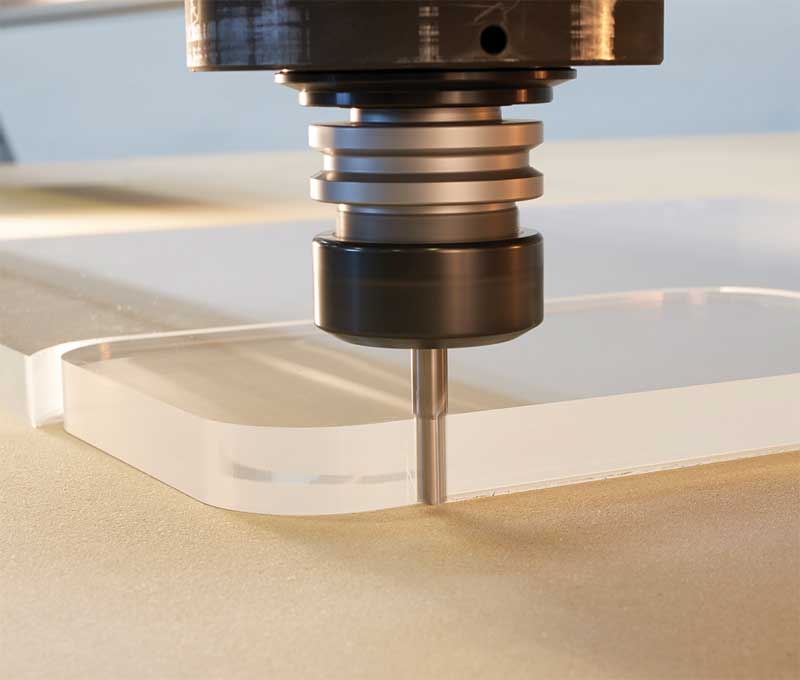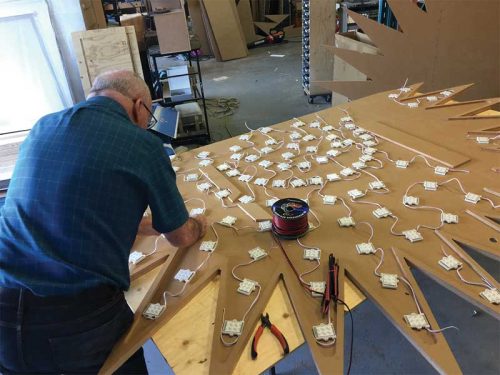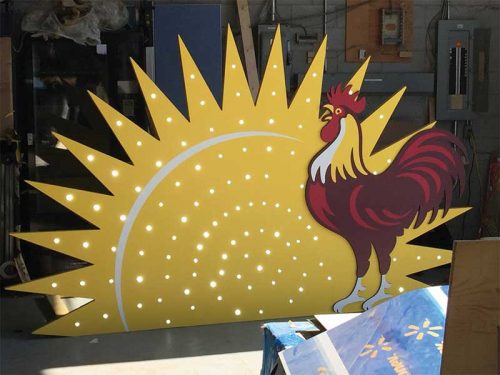A competitive edge for point-of-purchase display fabrication
by | 18 March 2020 11:33 am
By Susan Mattine [1]
[1]
When consumers walk into any high-end retail store they are instantly captivated by the elegant display stands that grace the aisles. Smooth edges, brightly lit shelves, and innovative design entice people to take a closer look at the advertised product line or promotion of the month. Behind the layout of some of these displays is the mind of a creative genius. But what about the edge finishes? Without a versatile computer numerical control (CNC) machine, one might end up with edges that look sloppy and unprofessional.
In the business of creating point-of-purchase (POP) displays, this will either make or break the effectiveness of a presentation. To produce a smooth, polished cut and stay competitive in the demanding signage industry, a CNC machine is well worth the investment. Not only will cut edges look superior, but also steps like sanding and using a flame polisher will be eliminated. This saves time, improves production efficiency, and guarantees a quality finish every time.
What to look for in a CNC machine
Shopping around for a CNC machine can be overwhelming, especially when it is the first time as there are several features, tools, and accessories to choose from. That said, what does one really need to successfully create a POP display? A strong, reliable CNC machine is a great place to start. Also important, however, is machine cut and versatility. Together, these features make a CNC machine one of the most powerful cutting tools a signmaker can add to their shop. Other factors include:
-
A strong, rigid base
A heavy-duty CNC router allows one to couple a strong base with a stiff, solid gantry. A strong structure supports quality edge finishing, offering a robust and reliable unit while helping to minimize vibration and movement.
-
Helical rack systems and servo drive motors
These help to deliver smooth movement and greater accuracy. As a result, vibration is kept to a minimum. This allows materials to be cut at a higher speed, producing higher volumes without losing quality.
-
A competent vacuum hold-down system
 [2]
[2]To produce a smooth, polished cut and stay competitive in the demanding signage industry, a computer numerical control (CNC) machine is well worth the investment.
The vacuum hold down ensures material stays in the correct place throughout the cutting process. Even the slightest material movement can put the software program, spindle, and material out of sync, invariably ruining the piece completely.
Selecting the right tools
Choosing the right tools and accessories will have a huge impact on the quality of the edge, and the overall look of the POP display.
When choosing collets and router bits, signmakers should keep the following tips in mind:
Collets
-
Choose the right type of collet to fit the spindle
Collets come in all shapes and sizes; therefore, it is important to buy one that best suits the CNC machine to avoid ending up with poor edge quality. Using the wrong one can also damage the spindle, machine bed, and the collet itself.
-
The collets should be changed regularly
 [3]
[3]A technician from POP49 installs lights on a display that was cut on a computer numerical control (CNC) machine.
After three to six months of use, collets will no longer hold a router bit as straight and true as when they were new. Therefore, changing them regularly will help to prolong tool life. When inspecting a collet, metallic damage, such as bell mouthing or burrs, should be checked with every tool change.
If damage is visible, the collet should be discarded and replaced. This ensures operations run consistently, good cut quality is maintained, and the life of the cutting tools is prolonged.
-
Match the collet shank with the tool shank diameter
Manufacturers often quote sizes in metric and imperial; therefore, it is important to read the data correctly to avoid mistakes. One common mistake is trying to fit a 6-mm (0.23-in.) shank tool into a 6.35-mm (0.25-in.) collet. It will go in and it can be tightened, but since it is not the right fit, it will put stress on the collet.
Router bits
-
Determine what type of flute is needed
 [4]
[4]The light display product is complete.
There is an enormous choice of CNC router tooling available (e.g. single, twin, or triple flute) and all factors (material, density, etc.) need to be considered carefully. Selecting the right tool for the job can make the difference between a perfectly smooth and clean cut, or something that looks like it has been hacked out with a saw. If one is not sure what tooling to use they should contact a CNC expert for guidance.
-
Understand the difference between spiral bits
If one wants the bottom side of a part to look polished an ‘upcut’ spiral bit should be used. If it is the top side, a ‘downcut’ spiral bit is needed. Other points to consider involve effective chip extraction and how thick the material is. The ‘upcut’ spiral bit is better at cutting thicker materials and has the best chip extraction rate, while the ‘downcut’ spiral bit is best used for materials that are 3.17 mm (0.125 in.) or thinner. However, due to the reduced cutting speed required when using ‘downcut’ spiral bits, they are less effective with chip extraction.
-
Choosing the right tool
 [5]
[5]Fabricating parts on their computer numerical control (CNC) router, POP49 expanded their product line to offer a myriad of promotional products, working with materials like plywood, polyvinyl chloride (PVC) and acrylic plastics, aluminum, as well as exotic woods and printed materials.
To achieve the best cut quality, it is important to always choose the tool with the shortest flute length that will cut through the material being used. This helps reduce cutter deflection and chatter. For example, the longer the router bit, the more it will deflect. When Ricky Pacheco bought his first CNC router in 2010, his company, POP49, in Mississauga, Ont., went from designing and manufacturing experiential assets for marketing clients to becoming a leader in innovative POP displays across North America, Mexico, and Puerto Rico.
Creating eye-popping POP displays
“I quickly realized it [the CNC router] to be the most versatile and useful tool in our collection of equipment,” says Pacheco, the company’s founder/director. “Being able to design and manufacture on demand has opened up a huge amount of potential to invent and prototype ideas at high quality and speed.”
With a background in marketing and mechanics, he started his business in 1989, combining his skills and experience to develop unique, high quality products for successful business branding. Fabricating parts on his CNC router helped him expand his product line to a myriad of promotional products, working with materials like plywood, polyvinyl chloride (PVC) and acrylic plastics, aluminum, as well as exotic woods and printed materials.
Like all signmakers, Pacheco is proud of his work, calling the level of repeatability and quality as superb.
“Having jobs duplicated years after they were first created and having them come out identical and perfect makes the client confident in our ability to sustain longer drawn out programs,” he says.

Selecting the right tool for the job can make the difference between a perfectly smooth and clean cut, or something that looks like it has been hacked out with a saw.
Along the way, Pacheco realized the importance of designing 3D products. Simultaneous three-axis control is a standard feature on most CNC routers that allows signmakers to cut complex and detailed 3D designs. This is an increasingly popular part of creating POP displays, signmaking, mould making, and many other applications.
“Designing in 3D is key,” says Pacheco. “Being able to show a client what the end product will look like makes all the difference.”
As far as CNC tooling goes, Pacheco recommends a combination of different router bits. He often uses compression, ‘downcut,’ ‘upcut,’ and straight flutes, and relies on the material to dictate which router bit is best. For his POP displays, he prefers ‘downcut’ and straight flutes. Although this means running the machine at a slower pace, he finds the end result to be a cleaner edge finish. He also recommends POP fabricators add a vision system to their inventory which comprises a high-performance camera mounted on the head of the CNC machine. This technology quickly finds and recognizes conventional registration marks, adjusting the machine cutting path as necessary to achieve exact alignment with printed shapes.
With all of his CNC tools and accessories in place, Pacheco enjoys working with his clients to bring their ideas to life.
“Seeing the look on a client’s face when they see something we have created makes everything we do worth it,” he says.
Susan Mattine is the communications and public relations associate for AXYZ Automation Group, a global leading manufacturer of tailored cutting solutions. She can be reached via email at smattine@axyz.com. For more information, visit axyz.com.
- [Image]: https://www.signmedia.ca/wp-content/uploads/2020/03/8024-AXYZ16436.jpg
- [Image]: https://www.signmedia.ca/wp-content/uploads/2020/03/infinite-5010-angle.jpg
- [Image]: https://www.signmedia.ca/wp-content/uploads/2020/03/Technician300dpi.jpg
- [Image]: https://www.signmedia.ca/wp-content/uploads/2020/03/Rooster300dpi.jpg
- [Image]: https://www.signmedia.ca/wp-content/uploads/2020/03/Pepsi300dpi.jpg
Source URL: https://www.signmedia.ca/a-competitive-edge-for-point-of-purchase-display-fabrication/